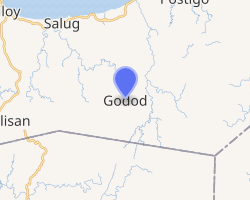Godod
Godod, officially the Municipality of Godod (Cebuano: Lungsod sa Godod; Subanen: Benwa Godod; Chavacano: Municipalidad de Godod; Tagalog: Bayan ng Godod), is a 4th class municipality in the province of Zamboanga del Norte, Philippines. According to the 2015 census, it has a population of 17,424 people.[3]
Godod | |
|---|---|
| Municipality of Godod | |
| Nickname(s): Heart of the Peninsula | |
 Map of Zamboanga del Norte with Godod highlighted | |
OpenStreetMap 
| |
.svg.png) Godod Location within the Philippines | |
| Coordinates: 8°00′05″N 122°50′38″E | |
| Country | |
| Region | Zamboanga Peninsula (Region IX) |
| Province | Zamboanga del Norte |
| District | 3rd District |
| Founded | February 8, 1982 |
| Barangays | 17 (see Barangays) |
| Government | |
| • Type | Sangguniang Bayan |
| • Mayor | Abel M. Matildo |
| • Vice Mayor | Ferdinand J. Caboverde |
| • Congressman | Isagani S. Amatong |
| • Electorate | 11,664 voters (2019) |
| Area | |
| • Total | 190.00 km2 (73.36 sq mi) |
| Population (2015 census)[3] | |
| • Total | 17,424 |
| • Density | 92/km2 (240/sq mi) |
| • Households | 3,791 |
| Economy | |
| • Income class | 4th municipal income class |
| • Poverty incidence | 68.23% (2015)[4] |
| • Revenue (₱) | 106,935,159.30 (2016) |
| Time zone | UTC+8 (PST) |
| ZIP code | 7100 |
| PSGC | |
| IDD : area code | +63 (0)65 |
| Climate type | tropical climate |
| Native languages | Subanon language Cebuano Chavacano Tagalog |
| Website | godod |
Barangays
Godod is politically subdivided into 17 barangays.
- Baluno
- Banuangan
- Bunawan
- Delucot
- Dipopor
- Guisapong
- Limbonga (Limboangan)
- Lomogom
- Mauswagon
- Miampic
- Poblacion
- Raba
- Rambon
- San Pedro
- Sarawagan
- Sianan
- Sioran
Climate
| Climate data for Godod, Zamboanga del Norte | |||||||||||||
|---|---|---|---|---|---|---|---|---|---|---|---|---|---|
| Month | Jan | Feb | Mar | Apr | May | Jun | Jul | Aug | Sep | Oct | Nov | Dec | Year |
| Average high °C (°F) | 28 (82) |
28 (82) |
29 (84) |
29 (84) |
28 (82) |
27 (81) |
27 (81) |
27 (81) |
27 (81) |
27 (81) |
27 (81) |
28 (82) |
28 (82) |
| Average low °C (°F) | 21 (70) |
21 (70) |
21 (70) |
22 (72) |
23 (73) |
23 (73) |
23 (73) |
22 (72) |
23 (73) |
23 (73) |
22 (72) |
22 (72) |
22 (72) |
| Average precipitation mm (inches) | 96 (3.8) |
79 (3.1) |
117 (4.6) |
127 (5.0) |
239 (9.4) |
301 (11.9) |
286 (11.3) |
283 (11.1) |
255 (10.0) |
272 (10.7) |
188 (7.4) |
115 (4.5) |
2,358 (92.8) |
| Average rainy days | 17.3 | 16.0 | 19.7 | 21.6 | 29.0 | 29.0 | 29.7 | 29.1 | 28.5 | 28.9 | 25.3 | 20.0 | 294.1 |
| Source: Meteoblue [5] | |||||||||||||
Demographics
| Year | Pop. | ±% p.a. |
|---|---|---|
| 1990 | 11,830 | — |
| 1995 | 15,053 | +4.62% |
| 2000 | 15,139 | +0.12% |
| 2010 | 17,788 | +1.63% |
| 2015 | 17,424 | −0.39% |
| Source: Philippine Statistics Authority[3][6][7][8] | ||
gollark: You're right, it'll only almost exceed it.
gollark: Won't that immediately exceed your storage limit?
gollark: We could put in *hyper*sentient regices I guess.
gollark: My mental architecture is immune to memetic kill agents anyway.
gollark: We should clearly devise a better digital protocol.
References
- "Municipality". Quezon City, Philippines: Department of the Interior and Local Government. Retrieved 31 May 2013.
- "Province: Zamboanga del Norte". PSGC Interactive. Quezon City, Philippines: Philippine Statistics Authority. Retrieved 12 November 2016.
- Census of Population (2015). "Region IX (Zamboanga Peninsula)". Total Population by Province, City, Municipality and Barangay. PSA. Retrieved 20 June 2016.
- "PSA releases the 2015 Municipal and City Level Poverty Estimates". Quezon City, Philippines. Retrieved 12 October 2019.
- "Godod: Average Temperatures and Rainfall". Meteoblue. Retrieved 30 April 2020.
- Census of Population and Housing (2010). "Region IX (Zamboanga Peninsula)". Total Population by Province, City, Municipality and Barangay. NSO. Retrieved 29 June 2016.
- Censuses of Population (1903–2007). "Region IX (Zamboanga Peninsula)". Table 1. Population Enumerated in Various Censuses by Province/Highly Urbanized City: 1903 to 2007. NSO.
- "Province of Zamboanga del Norte". Municipality Population Data. Local Water Utilities Administration Research Division. Retrieved 17 December 2016.
External links
This article is issued from Wikipedia. The text is licensed under Creative Commons - Attribution - Sharealike. Additional terms may apply for the media files.